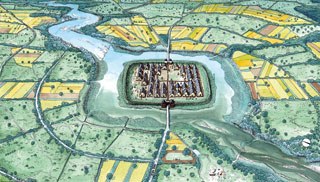The Terramare
 During the early decades of the 19th century, the word terramare was used to indicate deposits of organic material dug up from small mounds that were a regular feature of the landscape of the Po plain. These mounds were not natural in origin; their soil, which contained many archaeological remains, was sold as compost to fertilise the fields. For a long time it was thought that these deposits came from Roman or Celtic dwellings or burial grounds. Not until 1860, when research into prehistoric Italy grew more intense, did it become apparent that these mounds were created by Bronze Age settlements. From that time on, the term terramare has been used by archaeologists to refer to these settlements. As a result of numerous excavations the terramare became famous throughout Europe, and their archaeological remains added to the treasure store of the Region’s museums. Excavations carried out in the last twenty years have shown that the terramare were fortified villages dating back to the Middle and Recent Bronze Age (circa 1650 – 1170 BC), surrounded by earthworks and a ditch. The dimensions of these settlements varied: in their earliest phase they occupied 1-2 hectares, while in their more advanced phase they occupied up to 20 hectares.
During the early decades of the 19th century, the word terramare was used to indicate deposits of organic material dug up from small mounds that were a regular feature of the landscape of the Po plain. These mounds were not natural in origin; their soil, which contained many archaeological remains, was sold as compost to fertilise the fields. For a long time it was thought that these deposits came from Roman or Celtic dwellings or burial grounds. Not until 1860, when research into prehistoric Italy grew more intense, did it become apparent that these mounds were created by Bronze Age settlements. From that time on, the term terramare has been used by archaeologists to refer to these settlements. As a result of numerous excavations the terramare became famous throughout Europe, and their archaeological remains added to the treasure store of the Region’s museums. Excavations carried out in the last twenty years have shown that the terramare were fortified villages dating back to the Middle and Recent Bronze Age (circa 1650 – 1170 BC), surrounded by earthworks and a ditch. The dimensions of these settlements varied: in their earliest phase they occupied 1-2 hectares, while in their more advanced phase they occupied up to 20 hectares.
The houses were arranged inside the village following a regular perpendicular layout and were often built on stilts like pile-dwellings, even if, unlike the latter, they were not located by lakes or rivers. Narrow streets between 1,5 and 2,5 metres in width ran between the houses. Broader streets were probably the settlement’s main thoroughfares. Other spaces were used for livestock, deposits and meeting places.
The villages were very common, and the area between the Emilian plain and the lowlands in the provinces of Cremona, Mantova and Verona had a population density that was striking for its time: estimates put the population at between 150,000 and 200,000.
Society was organised on a participatory model that involved the whole community, even if the evidence suggests that there were economic and social differences. Apart from chiefs, the warrior caste was the emerging elite, and their womenfolk must also have enjoyed privileged status. Craftsmen who worked with metal played a key role, producing swords, daggers, spears, broaches, buckles, razors, but also farming implements such as scythes. During the later phases, differences between the villages must have been more marked, and more important centres began to emerge. Next to these, centres of minor importance developed.
Around 1200 BC, the terramare settlements underwent a demise, and within a couple of decades they disappeared. Archaeologists do not yet know the reason for this sudden demise, but it is possible that a series of man-made and natural causes led to the end of the terramare system. Climate change, albeit slight, may have provoked a crisis in the land-economy system which sustained the terramare population. However, climate change alone does not appear to be the only factor in the drastic collapse. Exactly why the terramare culture ended is still an unresolved mystery.
